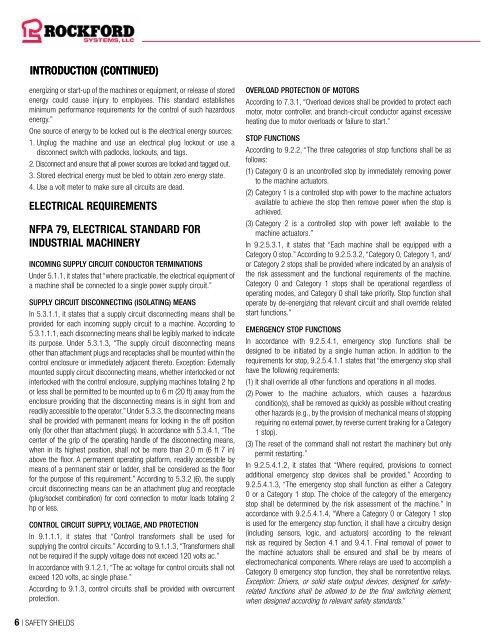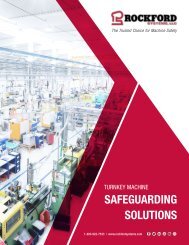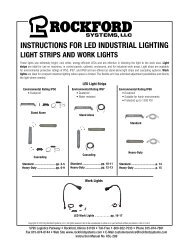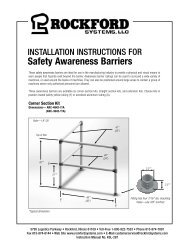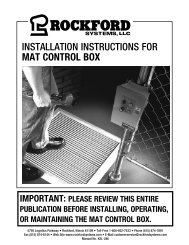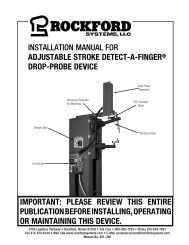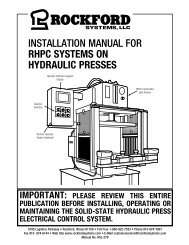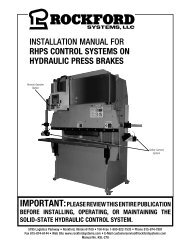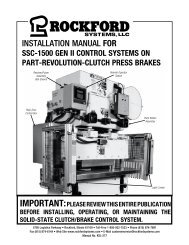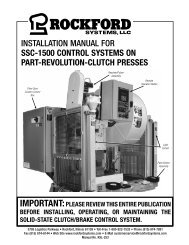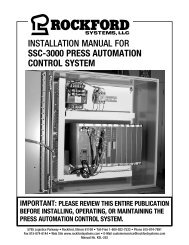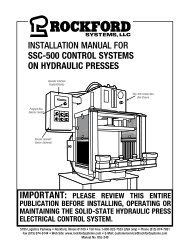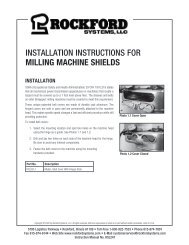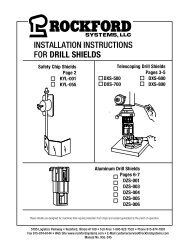Rockford Systems Turnkey Safeguarding Solutions Catalog (all in one)
Comprehensive 370-page catalog that combines all of our catalogs into one handy resource, specifically our Rockford Systems Introductory Brochure, our Safety Shields Catalog for Cutting and Turning Machines, our Machine Safeguarding Devices for Industrial Machinery, our EX-AL™ Barrier and Perimeter Guarding Systems, our Hand-Feeding Tools for Presses and Press Brakes, our Control Systems for Presses and Press Brakes, our Die Safety Blocks for Presses and Press Brakes, our Machine Safeguarding Seminars Brochure, and our Quick Reference Sheets Brochure.
Comprehensive 370-page catalog that combines all of our catalogs into one handy resource, specifically our Rockford Systems Introductory Brochure, our Safety Shields Catalog for Cutting and Turning Machines, our Machine Safeguarding Devices for Industrial Machinery, our EX-AL™ Barrier and Perimeter Guarding Systems, our Hand-Feeding Tools for Presses and Press Brakes, our Control Systems for Presses and Press Brakes, our Die Safety Blocks for Presses and Press Brakes, our Machine Safeguarding Seminars Brochure, and our Quick Reference Sheets Brochure.
Create successful ePaper yourself
Turn your PDF publications into a flip-book with our unique Google optimized e-Paper software.
INTRODUCTION (CONTINUED)<br />
energiz<strong>in</strong>g or start-up of the mach<strong>in</strong>es or equipment, or release of stored<br />
energy could cause <strong>in</strong>jury to employees. This standard establishes<br />
m<strong>in</strong>imum performance requirements for the control of such hazardous<br />
energy.”<br />
One source of energy to be locked out is the electrical energy sources:<br />
1. Unplug the mach<strong>in</strong>e and use an electrical plug lockout or use a<br />
disconnect switch with padlocks, lockouts, and tags.<br />
2. Disconnect and ensure that <strong>all</strong> power sources are locked and tagged out.<br />
3. Stored electrical energy must be bled to obta<strong>in</strong> zero energy state.<br />
4. Use a volt meter to make sure <strong>all</strong> circuits are dead.<br />
ELECTRICAL REQUIREMENTS<br />
NFPA 79, ELECTRICAL STANDARD FOR<br />
INDUSTRIAL MACHINERY<br />
INCOMING SUPPLY CIRCUIT CONDUCTOR TERMINATIONS<br />
Under 5.1.1, it states that “where practicable, the electrical equipment of<br />
a mach<strong>in</strong>e sh<strong>all</strong> be connected to a s<strong>in</strong>gle power supply circuit.”<br />
SUPPLY CIRCUIT DISCONNECTING (ISOLATING) MEANS<br />
In 5.3.1.1, it states that a supply circuit disconnect<strong>in</strong>g means sh<strong>all</strong> be<br />
provided for each <strong>in</strong>com<strong>in</strong>g supply circuit to a mach<strong>in</strong>e. Accord<strong>in</strong>g to<br />
5.3.1.1.1, each disconnect<strong>in</strong>g means sh<strong>all</strong> be legibly marked to <strong>in</strong>dicate<br />
its purpose. Under 5.3.1.3, “The supply circuit disconnect<strong>in</strong>g means<br />
other than attachment plugs and receptacles sh<strong>all</strong> be mounted with<strong>in</strong> the<br />
control enclosure or immediately adjacent thereto. Exception: Extern<strong>all</strong>y<br />
mounted supply circuit disconnect<strong>in</strong>g means, whether <strong>in</strong>terlocked or not<br />
<strong>in</strong>terlocked with the control enclosure, supply<strong>in</strong>g mach<strong>in</strong>es total<strong>in</strong>g 2 hp<br />
or less sh<strong>all</strong> be permitted to be mounted up to 6 m (20 ft) away from the<br />
enclosure provid<strong>in</strong>g that the disconnect<strong>in</strong>g means is <strong>in</strong> sight from and<br />
readily accessible to the operator.” Under 5.3.3, the disconnect<strong>in</strong>g means<br />
sh<strong>all</strong> be provided with permanent means for lock<strong>in</strong>g <strong>in</strong> the off position<br />
only (for other than attachment plugs). In accordance with 5.3.4.1, “The<br />
center of the grip of the operat<strong>in</strong>g handle of the disconnect<strong>in</strong>g means,<br />
when <strong>in</strong> its highest position, sh<strong>all</strong> not be more than 2.0 m (6 ft 7 <strong>in</strong>)<br />
above the floor. A permanent operat<strong>in</strong>g platform, readily accessible by<br />
means of a permanent stair or ladder, sh<strong>all</strong> be considered as the floor<br />
for the purpose of this requirement.” Accord<strong>in</strong>g to 5.3.2 (6), the supply<br />
circuit disconnect<strong>in</strong>g means can be an attachment plug and receptacle<br />
(plug/socket comb<strong>in</strong>ation) for cord connection to motor loads total<strong>in</strong>g 2<br />
hp or less.<br />
CONTROL CIRCUIT SUPPLY, VOLTAGE, AND PROTECTION<br />
In 9.1.1.1, it states that “Control transformers sh<strong>all</strong> be used for<br />
supply<strong>in</strong>g the control circuits.” Accord<strong>in</strong>g to 9.1.1.3, “Transformers sh<strong>all</strong><br />
not be required if the supply voltage does not exceed 120 volts ac.”<br />
In accordance with 9.1.2.1, “The ac voltage for control circuits sh<strong>all</strong> not<br />
exceed 120 volts, ac s<strong>in</strong>gle phase.”<br />
Accord<strong>in</strong>g to 9.1.3, control circuits sh<strong>all</strong> be provided with overcurrent<br />
protection.<br />
OVERLOAD PROTECTION OF MOTORS<br />
Accord<strong>in</strong>g to 7.3.1, “Overload devices sh<strong>all</strong> be provided to protect each<br />
motor, motor controller, and branch-circuit conductor aga<strong>in</strong>st excessive<br />
heat<strong>in</strong>g due to motor overloads or failure to start.”<br />
STOP FUNCTIONS<br />
Accord<strong>in</strong>g to 9.2.2, “The three categories of stop functions sh<strong>all</strong> be as<br />
follows:<br />
(1) Category 0 is an uncontrolled stop by immediately remov<strong>in</strong>g power<br />
to the mach<strong>in</strong>e actuators.<br />
(2) Category 1 is a controlled stop with power to the mach<strong>in</strong>e actuators<br />
available to achieve the stop then remove power when the stop is<br />
achieved.<br />
(3) Category 2 is a controlled stop with power left available to the<br />
mach<strong>in</strong>e actuators.”<br />
In 9.2.5.3.1, it states that “Each mach<strong>in</strong>e sh<strong>all</strong> be equipped with a<br />
Category 0 stop.” Accord<strong>in</strong>g to 9.2.5.3.2, “Category 0, Category 1, and/<br />
or Category 2 stops sh<strong>all</strong> be provided where <strong>in</strong>dicated by an analysis of<br />
the risk assessment and the functional requirements of the mach<strong>in</strong>e.<br />
Category 0 and Category 1 stops sh<strong>all</strong> be operational regardless of<br />
operat<strong>in</strong>g modes, and Category 0 sh<strong>all</strong> take priority. Stop function sh<strong>all</strong><br />
operate by de-energiz<strong>in</strong>g that relevant circuit and sh<strong>all</strong> override related<br />
start functions.”<br />
EMERGENCY STOP FUNCTIONS<br />
In accordance with 9.2.5.4.1, emergency stop functions sh<strong>all</strong> be<br />
designed to be <strong>in</strong>itiated by a s<strong>in</strong>gle human action. In addition to the<br />
requirements for stop, 9.2.5.4.1.1 states that “the emergency stop sh<strong>all</strong><br />
have the follow<strong>in</strong>g requirements:<br />
(1) It sh<strong>all</strong> override <strong>all</strong> other functions and operations <strong>in</strong> <strong>all</strong> modes.<br />
(2) Power to the mach<strong>in</strong>e actuators, which causes a hazardous<br />
condition(s), sh<strong>all</strong> be removed as quickly as possible without creat<strong>in</strong>g<br />
other hazards (e.g., by the provision of mechanical means of stopp<strong>in</strong>g<br />
requir<strong>in</strong>g no external power, by reverse current brak<strong>in</strong>g for a Category<br />
1 stop).<br />
(3) The reset of the command sh<strong>all</strong> not restart the mach<strong>in</strong>ery but only<br />
permit restart<strong>in</strong>g.”<br />
In 9.2.5.4.1.2, it states that “Where required, provisions to connect<br />
additional emergency stop devices sh<strong>all</strong> be provided.” Accord<strong>in</strong>g to<br />
9.2.5.4.1.3, “The emergency stop sh<strong>all</strong> function as either a Category<br />
0 or a Category 1 stop. The choice of the category of the emergency<br />
stop sh<strong>all</strong> be determ<strong>in</strong>ed by the risk assessment of the mach<strong>in</strong>e.” In<br />
accordance with 9.2.5.4.1.4, “Where a Category 0 or Category 1 stop<br />
is used for the emergency stop function, it sh<strong>all</strong> have a circuitry design<br />
(<strong>in</strong>clud<strong>in</strong>g sensors, logic, and actuators) accord<strong>in</strong>g to the relevant<br />
risk as required by Section 4.1 and 9.4.1. F<strong>in</strong>al removal of power to<br />
the mach<strong>in</strong>e actuators sh<strong>all</strong> be ensured and sh<strong>all</strong> be by means of<br />
electromechanical comp<strong>one</strong>nts. Where relays are used to accomplish a<br />
Category 0 emergency stop function, they sh<strong>all</strong> be nonretentive relays.<br />
Exception: Drivers, or solid state output devices, designed for safetyrelated<br />
functions sh<strong>all</strong> be <strong>all</strong>owed to be the f<strong>in</strong>al switch<strong>in</strong>g element,<br />
when designed accord<strong>in</strong>g to relevant safety standards.”<br />
6 | SAFETY SHIELDS


